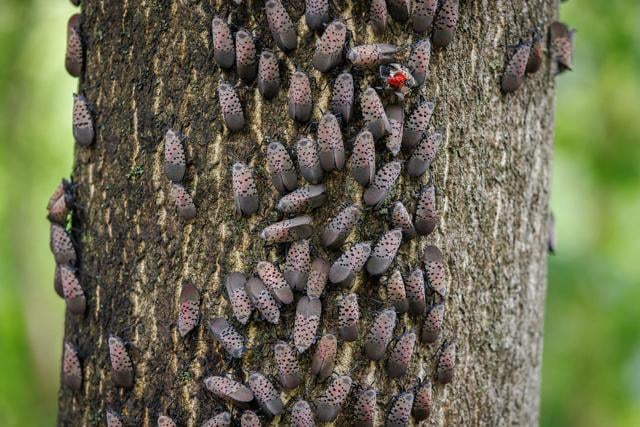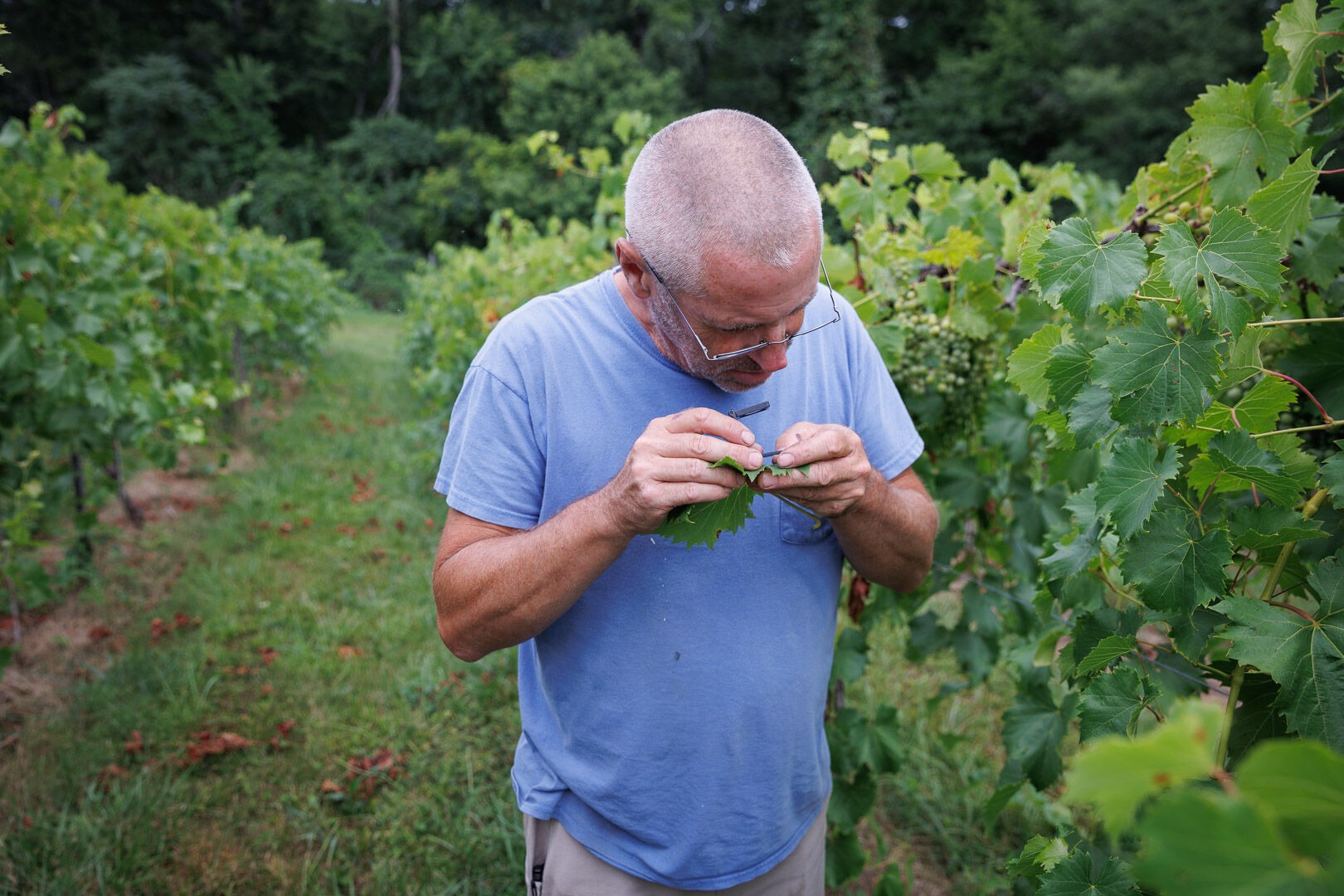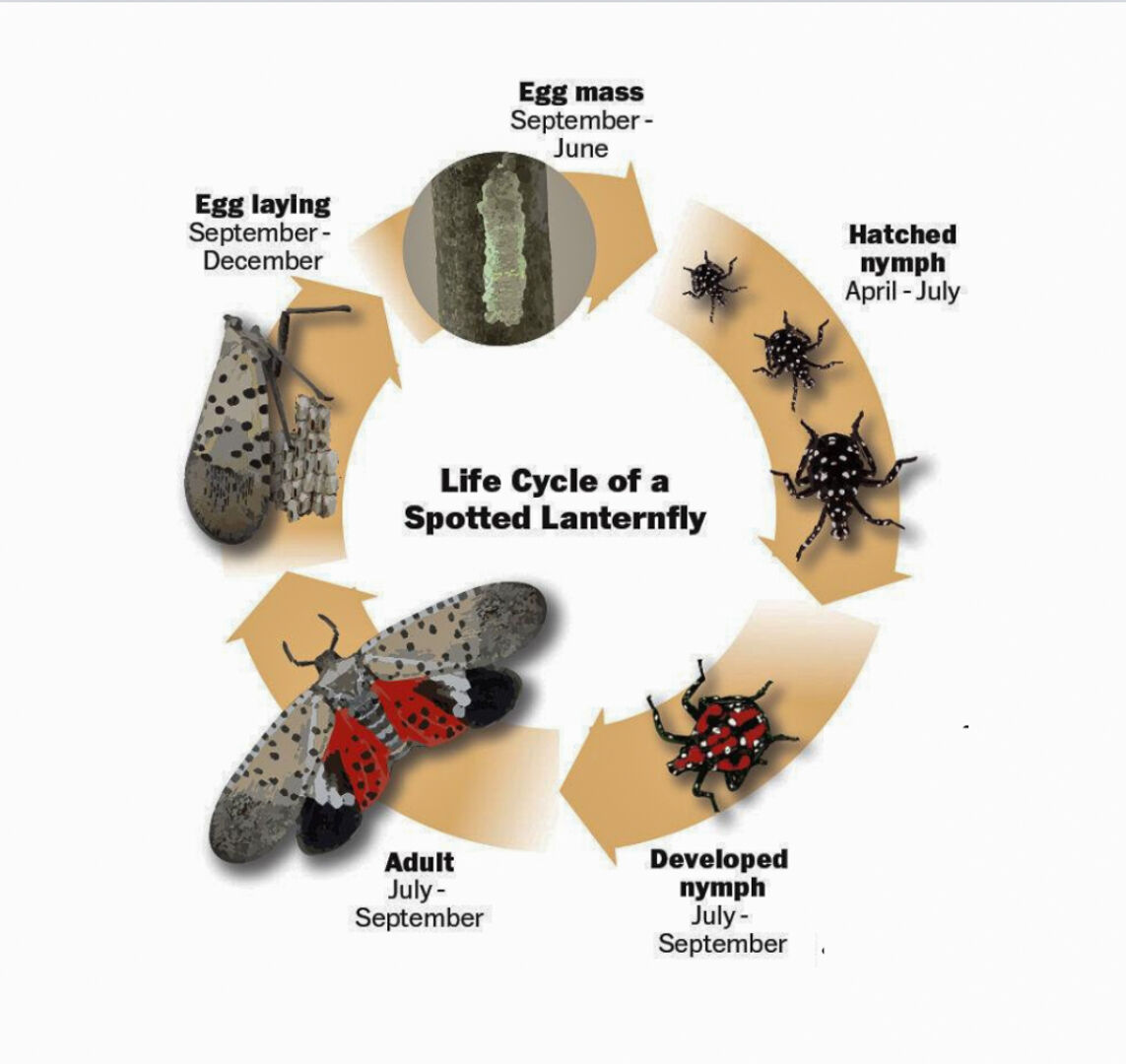Destructive insects detected in 50 Virginia counties
Throughout the summer, Ira Chaleff saw the occasional spotted lanternfly latched to the side of his home in Huntly. He thought nothing of it.
That was until a few weeks ago, when during a house party, one of his guests discovered that Chaleff was not just dealing with a few bugs here and there.
“He alerted me to the fact that I had an infestation,” Chaleff said.

2024-07-30-FF-lanternfly-2-web.jpg
Dozens of spotted lanternflies on a tree in Huntly.
Chaleff walked around his property and saw hundreds of spotted lanternflies — an invasive insect with a reputation for destruction — covering the eight ailanthus trees growing in his yard. What especially appalled him was the black, sticky mold and honeydew sludge that completely encapsulated the trunks of the trees where the insects sat, feeding on sap.
“It was pretty startling,” Chaleff said. “It looked awful.”
Chaleff phoned exterminators and arborists, who all told him that this problem was not a unique one, calling his infestation “not even that bad.” He was told to either chop the trees, an expensive undertaking, or wait it out until the frost, when the bugs would die off naturally. “Oh joy,” he thought.
These polka-dotted pests have been wreaking havoc across the country since 2014 — presumably arriving via a shipment of stone from their native Southeast Asia —and in Virginia since 2018. Now they have made their home in Rappahannock County — and they have no plans for leaving.
Kenner Love, Virginia Cooperative Extension agent for Rappahannock County, says spotted lanternflies have been spreading rapidly through the state, and have been detected in 50 Virginia counties as of late July.
Love said the bugs are not strong fliers, but they are expert hitchhikers, which gives them the ability to spread swiftly, traveling distances much further than they could naturally by grasping onto vehicles or laying their eggs on train cars.
The majority of spotted lanternfly sightings in Rappahannock have occurred at vineyards, like Rappahannock Cellars in Huntly.
Vineyard manager Tom Kelly said his staff is working to combat the pests by using an oil spray recommended by Penn State University, which he said seems to be helping manage the nymph population, the development stage that spotted lanternflies reach before adulthood.

2024-07-18-FF-Lanternfly-7-web.jpg
Vineyard manager Tom Kelly looks for lanternfly damage in a row of Seyval Blanc vines at Rappahannock Cellars in Huntly.
“We haven’t seen high concentrations of nymphs which you normally would, given the number of egg masses we’ve found,” Kelly said. “[But] nothing’s going to be 100% . . . I think it’s going to be a manageable problem, but it’s going to be another thing we have to fight.”
Destructive appetites
The issue with spotted lanternflies is their eating habits. As lanternflies feast on trees and grapevines, puncturing the bark to access the sap inside, they cause damage that weakens or kills the plant, according to the Virginia Cooperative Extension. They also secrete a sugar-rich honeydew substance onto the host plant, says Love, attracting other pests and creating the perfect home for black sooty mold to grow.
“That is one of the consequences of having a major infestation,” says Dr. Mizuho Nita of the Alson H. Smith Jr. Agricultural Research and Extension Center in Winchester. “Insects may or may not kill the trees, but they do create an environment where the other microorganisms can grow.”
As vineyards are pushed by the lanternflies to use more and more pesticides, biological controls —beneficial insects like ladybugs, predatory mites and parasitic wasps — are also diminished. But if vines are left untreated against spotted lanternflies, Love said an entire vineyard could be lost.
Searching for solutions
Statewide, researchers are looking into ways to protect crops and nursery plants, and slow the spread of the bugs. One intervention that Love said has been implemented for invasives in the past, and may be used again, is the introduction of parasitic wasp populations that would infest spotted lanternfly eggs, quelling their numbers.
Spotted lanternflies favor invasive ailanthus trees —also known as tree of heaven. He said experts differ on whether to try and eliminate the invasive trees, or use the bug’s favorite food to their advantage in the fight against exponential growth.
“If you leave [a tree of heaven] in your landscape, you can treat it with a systemic insecticide to kill the insects in their feeding. If you take that tree down, then those insects are going to find another source of food, maybe a maple in your lawn,” Love said.

Lanternfly Map_ Newest-web.jpg
Bill Gadino, owner of Gadino Cellars in Washington, opted to implement the “hack and squirt” method at his vineyard two years ago, in which the trunk of an ailanthus tree is cut and herbicide is sprayed inside. While Gadino said he has seen success with killing these trees around his vineyard, they still line the roads of the county.
Love said spotted lanternflies do not pose a major threat to local peach and apple orchards. Likewise, the odds are low that they will cause problems for hardwood trees, according to local forester Jeremy Clem.

Lanternfly Lifecycle-web.jpg
Love said that although the spotted lanternfly will probably never be “eradicated,” as predators catch up with them, the numbers will decline, becoming another insect on the list of pests for farms and vineyards to manage. Love compared their presence to that of brown marmorated stink bugs, which ran rampant for several years before the population growth plateaued, integrating into the local ecosystem.
“Now, the cat’s out of the bag, we can’t really put it back in,” Love said. “I don’t think we’ll ever eradicate, but as the biological system kind of catches up, then … the numbers will moderate so we won’t be overwhelmed.”
What to do if you spot lanternflies
County residents are urged to keep an eye out for spotted lanternflies in all stages of life, from eggs to nymphs to adults, and report them to the Rappahannock County Virginia Cooperative Extension office at (540) 675-3619, or email extension agent Kenner Love at [email protected].
The United States Department of Agriculture encourages residents in affected areas to “smash” the bugs and “squash” egg masses, scrape remnants into a plastic Ziploc bag filled with hand sanitizer or rubbing alcohol, then zip the bag up and throw it in the trash.
For more general information about spotted lanternflies in Virginia, visit: https://www.ento.vt.edu/4-H_Entomology/SpottedLanternfly.html
Sign up for Rapp News Daily, a free newsletter delivered to your email inbox every morning.







